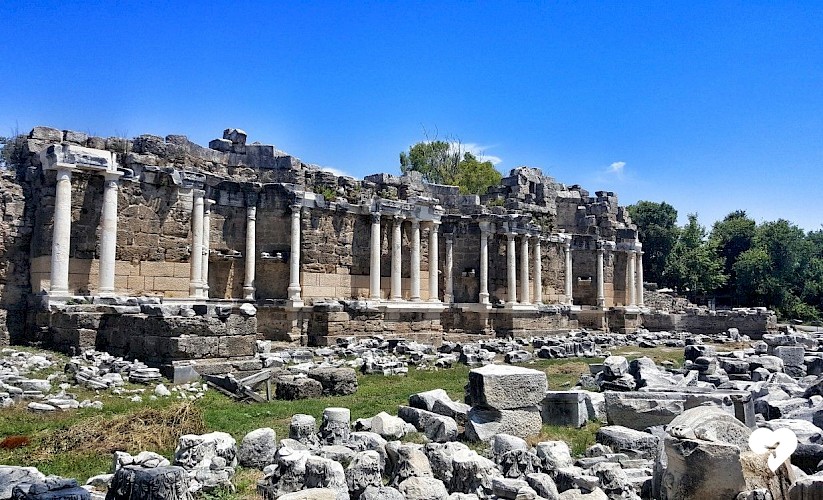Turquoise sea, golden sand, light glistening on ancient ruins… A dream painted in sunset hues…
Shaped by the cooling waters and soft sands of the Mediterranean, heir to the riches of antiquity and child of the modern world, Side is the perfect destination, equally rich in ancient treasures and the gems of contemporary entertainment, shopping and comfortable accommodation.
Side is a superb choice for a holiday, whether your aim is to bath in sun, sea and sand, or to repose in harmony with nature under a soft, leafy canopy, or to explore the region's unparalleled history, wandering mesmerised through the ruins of antiquity.
Here sea and sky exist in perfect harmony, and where the waters meet the side of the peninsula, golden beaches give on to ancient ruins, cafes, superb restaurants and souvenir shops. Natural marvels such as Manavgat Waterfall and Köprülü Canyon National Park are easily accessible. It’s all here.
Ruins of antiquity reflecting the spirit of time
The ancient Side was a centre of commerce, and the temples were built next to its harbour so that gods would protect it. One of these is the temple believed to have been devoted to Men, the God of Moon, which stands next to the other temples. The people of Side worshipped Cybele and Men before Athena and Apollo. During the Christian Era the temples of the sacred field were substituted for a basilica and a church. The basilica was built in 5th century AD, and the church was built in the 8th or 9th century.
The god and goddess of Side, Apollo and Athena, adorned the coins minted in here. The reverse, however, showed the pomegranate, the symbol of fertility and life represented by Cybele and Athena. The word "Side" itself means pomegranate. Small and large, from coins to temples, these ancient objects provide us highly valuable information regarding the history, beliefs, culture and daily life of Side.
Gateway to the masterpieces of antiquity
Ancient Side welcomes its visitors through the Main Gate, set between two towers of the insurmountable city walls, standing directly across from the monumental fountain. The Main Gate dates to the 2nd century, and together with the horse shoe shaped, colonnaded courtyard it was also used for ceremonial processions. The monumental fountain across from the gate had three wide arches and a basin, and it was also built in the 2nd century. It is the largest ancient fountain of Anatolia. Originally the structure had three levels and it was decorated with marble cladding and reliefs, however at present only a single level is standing and a few decorations of the pool can be seen. Manavgat River used to provide water to the fountain through aqueducts, splendid examples of human ingenuity working in tandem with the gifts of nature. Sections of the aqueducts are still visible.
%20copy.jpg) Photo: Gülcan Acar
Photo: Gülcan Acar
Passing through the Main Gate and courtyard there are two roads originally lined with corinthian columns: the main road that continues straight ahead, and another leading off to the left. The main road, which channelled the social and cultural life of ancient Side, is lined with porticoes providing sheltered access to the shops and houses, and passes through the agora and city centre where a bathhouse, a theatre, and fountains once stood. The road eventually reaches the tip of the peninsula, site of the harbour and temples, symbols of commerce and religion.
Agora where slaves famed for their beauty were sold
After entering ancient Side and proceeding on the main road, the groups of ruins on the left are from the bishopric basilica, surrounded with columns, and the palace. A little further down on the same road, again on the left is the commercial agora which is one of the two agorae the city. Apart from its traditional function as a venue for commerce and a forum to discuss the political and economic situation, the commercial agora of Side assumed another function. In the first century BC a passage was built that connected the commercial agora to the theatre nearby, and both the agora and the theatre served as a slave market. In the middle of the agora, where slaves famed for their beauty were traded, used to stand a temple devoted to Fortuna, the goddess of luck and trade, which had a round plan lined with 12 columns with corinthian capitals. The Agora was lined with porticos and large shops behind them.
At one corner of the agora, next to the theatre stood the latrina, the public toilets of the city. The latrina, which was a decorated structure covered with domes, and connected to the sewers laid under the main road, is a proof of excellence in city planning in Antiquity.
On the opposite side of the road across the agora stood the Roman Bathhouse from the 5th century, which now serves as a museum where magnificent sculptures, busts and sarcophagi are on permanent display.
The Museum of Side, which resembles Olympus, the home of the gods and goddesses
The Museum of Side, with the statues and figurines of gods and goddesses on display, seems like Olympus, the home of the gods and goddesses. Here the gods and goddesses of Olympus compete with each other to whisper myth and legend in the ear of visitors. Zeus, Aphrodite, Ares, Nike, Hygeia, Asclepius, Apollo, Hermes, Dionysus, Heracles, Tyche and Athena – the heroes and heroines of the legends that they narrate themselve in the Museum of Side.
